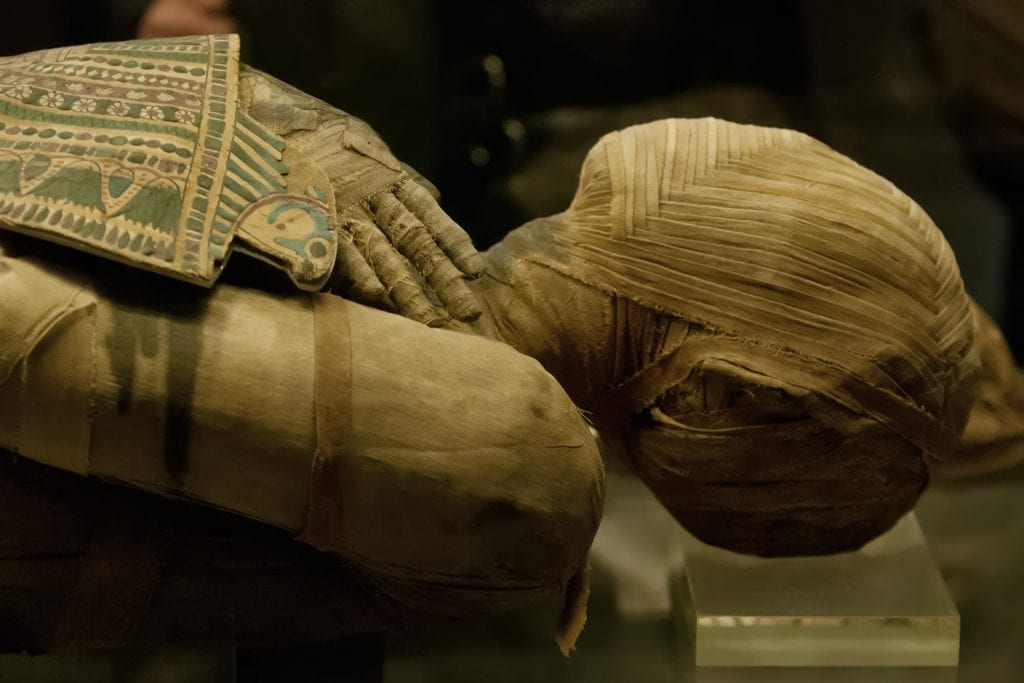Class Spotlight: Mummies: Life After Death

Note: Answers have been edited for length.
Associate Lecturer of Anthropology Sandra Wheeler, Ph.D., has been teaching at the University of Central Florida since 2010, with a specialty in bioarchaeology. Her course, called Mummies: Life After Death (ANT 4027), is a big hit among anthropological and non-anthropological majors alike.
College of Sciences: How did the idea for this course come about?
Wheeler: “I study human remains from archaeological contexts as a biological anthropologist. My focus of research is in Egypt, which naturally lends itself to encountering mummies. When I was thinking about what course would be interesting to take as an undergrad, mummies was an easy choice. But not just mummies; I wanted to talk about how we as anthropologists approach the study of mummies, and why different cultures decide to preserve their dead, and how they do that. We find preservation of the body or mummification all over the world, and it is one of the oldest patterns of intentional body disposal. I wanted to combine this idea of a global survey of different mummies found around the world with how we can use anthropological and scientific techniques to find out how cultures from around the world interacted (or interact) with their dead.”
College of Sciences: How has the anthropological study of mummies evolved and changed throughout the years?
Wheeler: “Ethics has definitely changed; it guides us in terms of the type of analyses we can do. We’ve seen major positive changes towards ethical responsibilities of researchers in the past couple of decades, though more work needs to be done. We are seeing a less colonialist approach, and more respect for artifacts and bodies stemming from a culture’s ancestry. There are a lot more opportunities for open dialogue with local populations, where anthropologists can engage with them and ask questions like, “Well what do you want to know about your ancestors?” or “What can we help you find out about your ancestors?”
College of Sciences: What are the uses and misuses of mummies?
Wheeler: “We actually have a whole module in the course on the uses and missuses of mummies. People used to use mummy fragments as paper, as medicine, people ingested them and used them in paint; the list goes on and on. I love anthropology because we get to engage with and try to understand the different beliefs of different culture groups. However, when you put some things into perspective, such as something as strange as endocannibalism (eating people within your community), you are able to look at it through a different perspective. This class can provoke different perspectives among students about death and about the uses of the mummified or preserved human body.”
College of Sciences: How widely practiced is mummification in 2019?
Wheeler: “In modern times there are still cultures around the world that practice mummification or preservation of the body. Those bodies live in their houses with them until their families can afford funerals. Many cultures see funerals as the most important part of your life because it ushers you into the next phase. It is this bigger idea that transcends cultures and connects us as humans to the physical body.”
College of Sciences: What can students look forward to learning in this course?
Wheeler: “What I have found in teaching this course is that initially students feel discomfort in learning the processes of decomposition. But then comes the understanding of how different cultures deal with death and have different rituals and ceremonies surrounding it. This gives students an alternative perspective on something as powerful as death. Grief is universal and we all experience it — even primates and other mammals. So having a broader understanding on such a topic is sometimes a comfort to students in this course and what many students enjoy about the class.”
College of Sciences: What is your personal favorite part of teaching this course?
Wheeler: “I really enjoy the intersection of anthropology and science as applied to the human experience of death. As anthropologists we are uniquely positioned to ask good questions about the process of body preservation and culturally why these bodies are preserved. What I enjoy most is showing the diversity in the human experience in dealing with purposely and naturally preserved bodies. Preservation of the body happens all over the world, not just Egypt, and I like to see student’s reactions when they realize this. This class is a great opportunity to have controversial discussions surrounding ethics, open dialogue with local communities and what the responsibilities of scientists and anthropologists are in the handling of mummies. We also do a mummification experiment using apple slices at the end of the course, and that is always a pleasure for me to read and engage with students.”
College of Sciences: Any other common misconceptions that pop up?
Wheeler: “So everyone is under the impression that the ancient Egyptians are the ones that came up with the process of mummification but actually, it dates back to ancient South America. That is the one misconception I debunk the most. If you have any other questions, come check the course out!”
